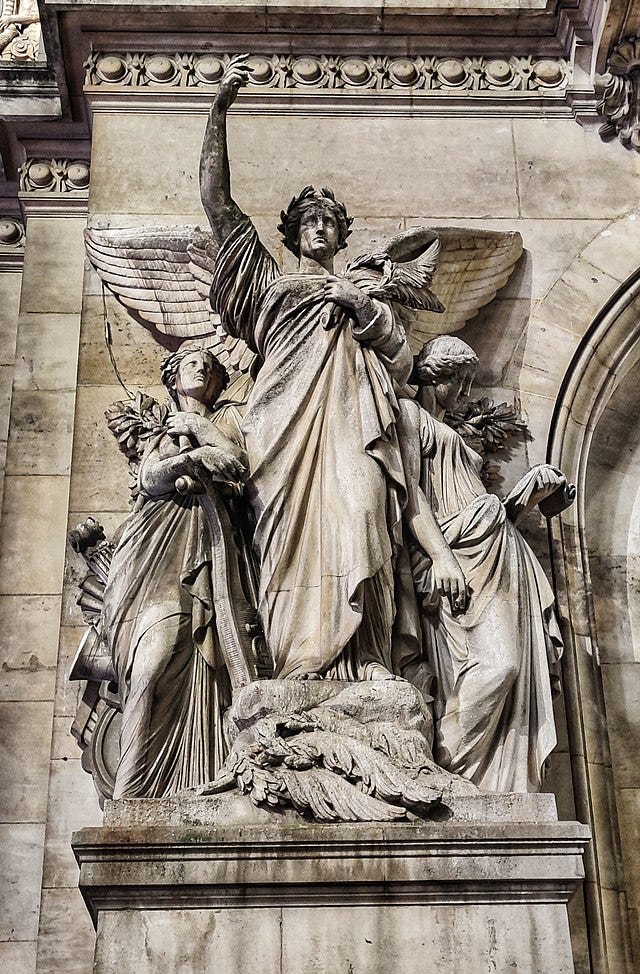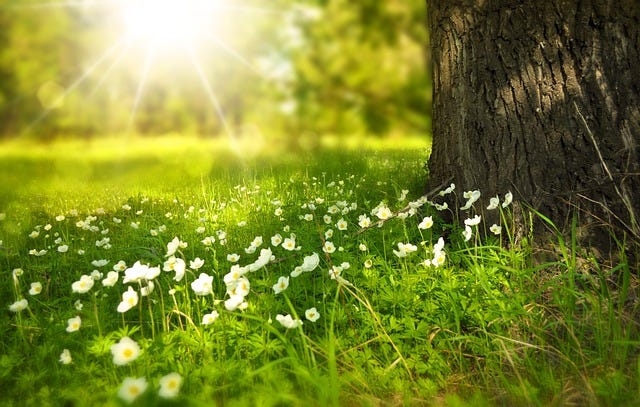Poetry's Rising Sun
Poetry and music as one, poems as songwriting inspiration, John Donne’s “The Sun Rising,” and how to bring poetry back to life
People are often surprised by my answer when they ask me who my biggest musical influences are. I play acoustic, so maybe they expect me to say Bob Dylan. My music could be billed as “country,” so maybe they suspect Johnny Cash.
They are generally pleasantly surprised when I say, “poets.”
Poets, not musicians, have always been my biggest musical influences.
My poet-mother recited (and still does recite) all different types of poetry to my sister and me. This included metrical poetry, poetry that has a distinct rhythm, rhyme, and feel. This instilled an early love of words right away. It also taught us young, music and the written word walk hand in hand.
While poets like T.S. Elliot and Henry Wadsworth Longfellow were bona fide rock stars in their respective days, it’s hard to even I.D. one poet that is considered to be a household name these days.
Why is that?
It’s due to a number of reasons, several of which I’ve covered here at Classically Cultured.
But one of the main reasons I haven’t touched on until today is because with the rise of free verse poetry, and the fading out of form poetry, this separation of poem from music has resulted in an overall decline in interest of the artistic medium itself.
Esteemed New Formalist poet Dana Gioia said this about the state of poetry:
“Poetry originated as a form of vocal music. It began as a performative and auditory medium, linked to music and dance and associated with civic ceremony, religious ritual, and magic. (The earliest poetry almost certainly served a shamanistic function.) Most aboriginal cultures did not distinguish poetry from song.... Nor did the classical Greek or Chinese cultures two or three millennia ago differentiate poetry from song.”
Gioia’s mention of Greece brings to mind Ancient Greek Philosopher Plato. In his Symposium, which is dated as far back as 370 BC, he mentions that philosopher and “priestess” Diotima once told Socrates that great poets create their work by way of “music and meter.”
Like songs, form poetry is easier to remember because of metrical verse, rhyming, and rhythm. This creates an intimate connection between the reader and the poem being read. This rhythmic essence also encourages poetry to be read aloud, fostering an even keener connection between groups of people and poetry itself. This is a big reason why Gioia still advocates for poetry to be read aloud, despite its ever-increasing introverted literary culture.
What happens when poetry breaks from music? Gioia offers an explanation by way of poet Ezra Pound, “Poetry withers and dies out when it leaves music, or at least imagined music.”
The question remains, how do we bring poetry back to life by way of music, or in Pound’s phrase, by way of “imagined music”?
A Smart and Unconventional Man
One of my favorite poets is 17th century Englishman John Donne.
He had a noble but rebellious spirit, and this greatness of soul colored his poetry.
Donne was born to a Catholic family during a time when practicing Catholicism was outlawed in England. Despite growing up during a time of religious upheaval, he ultimately became a cleric in the Church of England. Though he was a religious man, he spent much of his time studying and is regarded as a great scholar. He was a smart man, but an unconventional man, therefore, he became a poet.
His poetry is what he is most known for.
His stanzas are full of passion, intense imagery, and cheeky conversational tones.
His poetry can be enjoyed by both the scholar and the layman, and that is why it’s so brilliant.
But what does his poetry have to do with music?
The Dawning of a New Day
Donne is an original member of a movement called the “Metaphysical Poets.” These wordy guys were highly philosophical, and enjoyed exploring abstract ideas within their poems while offering concrete examples that brought their ideas down to earth.
While he was a Metaphysical poet, he was also a form poet, and his music has a rhythmic feel that waltzes, turns on a dime, and bows.
One of my favorite poems of his (though it’s hard to choose), is “The Sun Rising.”
Donne was a bit of a lothario, so many of his poems are hopelessly romantic. Despite the romantic feel, his words are full of confidence, pride, and dare I say, swagger.
For “The Sun Rising,” he paints a lazy picture of he and his lover lying in bed. But a powerful force beckons them back to reality, a “busy old fool,” the “unruly sun.”
From the opening lines, he takes us on a powerful morning trek without ever leaving he and his lover’s room. Concerning his Metaphysical style, he not only presents the sun as a powerful force that attempts to separate him and his lover, but he also paints the picture of him ultimately embodying the sun, so he can become the powerful force itself. He and his lover, then, will never part.
Before Love Songs There Were Love Poems
“The Sun Rising” is known as an “aubade.” This type of poem contains a theme centered around morning, and the dawning of a new day. The aubade was popular during Medieval times, particularly in France, where this type of poem was often set to music and performed by traveling musicians.
The dancing, rhythmic nature of the poem is rooted in its metrical style. Donne makes use of both iambic pentameters and iambic tetrameters. An “iamb” is a metrical unit, or “foot,” consisting of two syllables, both an unstressed and stressed syllable. Iambic pentameter is a rhythmic pattern consisting of five “iambs” per line. Iambic tetrameter contains four “iambs” within each line. I promise this is as technical as it gets today ;)
Because of Donne’s mixed use of meter, he creates a rhythm that ebbs and flows, much like the slow-moving rays of sun in the poem.
The poem’s lines that rhyme help root the rhythm and give the reader a firm place to land (especially if you are reciting it aloud).
The last few lines are knockouts. Much like the burning rays of a summer afternoon, Donne’s “The Sun Rising” will stay with you, warming your skin long after you’re done reading it.
“The Sun Rising,” a Reading
Not only is John Donne’s expressive poetry remembered for its emotion and imagery, but its form, meter, and rhyme create a memorable experience for the reader.
These musical poetic forms have long been an influence of mine.
While free verse remains supreme these days, with a resurgence of other form poets like Gioia, who is still very active in the poetry community these days, we can bring the literary medium out of the shadows and back in the spotlight where it belongs.
Still on the fence about why music and poetry were once considered, and should still be considered, as one?
Read “The Sun Rising” below, making note of its rhythm, rhymes, and intense emotion. Soon enough, you should hear the hidden music flowing through the words.
I’ve put some of my favorite lines of the poem in bold 🙂
And if you’d like to hear the poem read out loud, here’s a great reading by one of my favorite actors, John Lithgow (Remember 3rd Rock from the Sun?).
Enjoy!
The Sun Rising
by John DonneBusy old fool, unruly sun,
Why dost thou thus,
Through windows, and through curtains call on us?
Must to thy motions lovers' seasons run?
Saucy pedantic wretch, go chide
Late school boys and sour prentices,
Go tell court huntsmen that the king will ride,
Call country ants to harvest offices,
Love, all alike, no season knows nor clime,
Nor hours, days, months, which are the rags of time.Thy beams, so reverend and strong
Why shouldst thou think?
I could eclipse and cloud them with a wink,
But that I would not lose her sight so long;
If her eyes have not blinded thine,
Look, and tomorrow late, tell me,
Whether both th' Indias of spice and mine
Be where thou leftst them, or lie here with me.
Ask for those kings whom thou saw'st yesterday,
And thou shalt hear, All here in one bed lay.She's all states, and all princes, I,
Nothing else is.
Princes do but play us; compared to this,
All honor's mimic, all wealth alchemy.
Thou, sun, art half as happy as we,
In that the world's contracted thus.
Thine age asks ease, and since thy duties be
To warm the world, that's done in warming us.
Shine here to us, and thou art everywhere;
This bed thy center is, these walls, thy sphere.*This poem is in the public domain
Want to read more poetry? As we anticipate warmer weather, check out these five poems about summer (Donne’s “The Sun Rising” makes an appearance here as well):
Poetry Collection: 5 poems about summer
Shakespeare- “Shall I compare thee to a summer’s day?” Appearing in a collection of sonnets, this romantic Shakespeare poem is one of his most famous. He makes good use of his trademark Shakespearean sonnet form to compare his love’s beauty and allure to the beauty and allure a “summer’s day” brings.
Love Classically Cultured but aren’t quite ready to commit to a paid membership? Now you can make a one-time contribution to the Classically Cultured virtual tip jar by following this link. Every little bit helps fuel philosophical renaissance. Thank you for your support!







